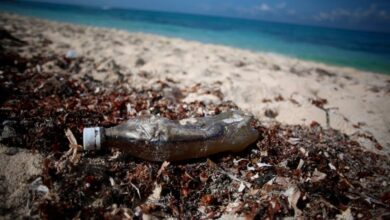New Paradigm, New Challenges: How Do We Solve Plastic Pollution?
Plastic pollution is growing at an alarming rate with serious consequences for our health, natural ecosystems and climate change. What are some of the projects to solve the negative effects of plastic waste? .

Photo: Pixabay
LatinAmerican Post | María Fernanda Camisay
Listen to this article
Leer en español: Nuevo paradigma, nuevos desafíos: ¿cómo solucionamos la contaminación por plásticos?
Whether in the home, the office or the neighborhood store, plastics are an integral part of our daily lives. Without being aware of it, we use a large number of objects made of this extraordinarily malleable, durable and versatile material on a daily basis. After 70 years of large-scale production, plastics have invaded different areas of human life, providing important benefits, as well as many drawbacks.
According to the latest report from the Organization for Economic Co-operation and Development (OECD), we produce twice as much plastic waste as two decades ago and it is estimated that we will triple the current values by 2060. Packaging material, beverage bottles, bags and disposable cutlery, are just some of the most common formats of plastics that are rarely used and thrown away. Recycling them is not easy or usual. Indeed, a good part of them end up in landfills, are incinerated or, worse still, leak into the environment.
Living in a plastic world
There is no remote and inaccessible place on the planet where there is no plastic. From the deepest and darkest trenches of the oceans to the highest and most remote mountains contain small portions of this material. Millions of tons of plastics flood the terrestrial and aquatic ecosystems of the planet, altering the habitats present there and causing damage to wildlife. In this regard, the World Health Organization (WHO) defines plastics as "the largest, most harmful and persistent fraction that represents at least 85% of the total waste in the oceans."
Since environmental health is closely related to human health, this type of pollution poses a real risk to humans. Recent research indicates that we breathe plastics through the air, consume them through food and water, and even absorb them through our skin. Although the effects of their exposure are still unknown, it is believed that they could have negative consequences on hormonal, metabolic, neurological and reproductive functions.
The magnitude of this problem knows and respects no limits. It is an environmental crisis that affects the entire world and therefore requires an international approach. In this context of urgency, at the beginning of March of this year, the highest leaders of the United Nations Assembly for the Environment, the main body for environmental decisions on the planet, met and approved a historic resolution to make against plastic pollution. This opinion, which promises to be the official path to definitive solutions, seeks to adopt a circular economy. That is, to intervene in the complete life cycle of plastic, including its production, design, recycling and disposal, through the application of a broad package of strategies. Below, we discuss some of the projects that could help overcome the plastic pandemic.
Reduce plastic production and consumption
The main objective is to promote a transition away from short-lived plastics, for example disposable containers and articles. These products are developed from low-quality materials, intended to be thrown away after their first use, so they are not reused. Likewise, little is recycled due to technical and economic limitations.
More than a decrease in general consumption, this intervention aims to eliminate unnecessary and completely avoidable plastics, as well as the change towards products and services that promote reuse. On the one hand, there are those alternatives that invite the consumer to make small changes, be it the use of cloth shopping bags or thermal cups for hot drinks. And on the other, those that force companies to innovate in their ways of providing profits, such as concentrated capsules or subscription services that dispatch products in reusable and returnable containers.
Replace plastic with eco-friendly materials
Plastics pollute when they are produced from petroleum derivatives, releasing toxic by-products into the atmosphere. And, after they are used, they pollute again. The vast majority of plastic waste is not biodegradable and takes hundreds of years to break down. Even recycling or incinerating them increases greenhouse gas emissions. For this reason, the more plastic is manufactured, the more fossil fuel is needed and the more climate change intensifies.
Also read: World Health Day: Why is the Climate Crisis a Health Crisis?
In the search for substitute materials, bioplastics are postulated as a promising option. Unlike synthetic plastic, the inputs do not come from fossil sources but are derived from renewable resources, such as plants, algae or organic waste. And they generally degrade faster. However, its use requires specific infrastructure, research, and citizen awareness so that its effects are not as harmful as conventional plastics.
Increase the efficiency of plastic recycling
Currently, the plastic recycling system does not reach its potential, as stated by the OECD in its annual report. The OECD warns that "globally, 15% of plastic waste is collected for recycling purposes, but only 9% is successfully recycled."
Certainly, mechanical recycling has its limitations and applies only to some plastics. New reconversion technologies are required that use chemical agents or processes to degrade plastics and transform them into basic components, thus creating other plastics or materials.
Although the chemical conversion is in early stages, the preliminary results of various studies demonstrate the feasibility of using selected microorganisms isolated from their natural habitats (such as, for example, from the intestines of "plastic-eating" superworms). Likewise, the use of biocatalysts or enzymes to break down those plastics that cannot be mechanically reduced, substituted or recycled.
The challenge is great, but there are reasons to be optimistic. According to the UN, “a shift towards a circular economy can reduce the volume of plastic reaching the oceans by more than 80% by 2040”. It only requires everyone's commitment.




